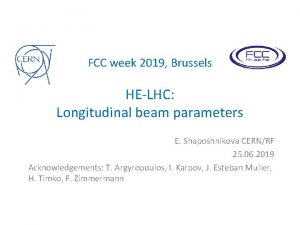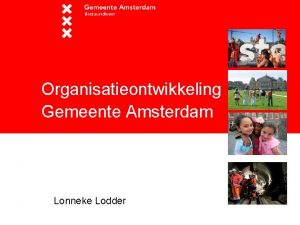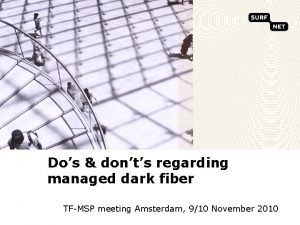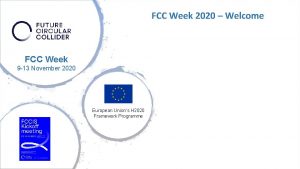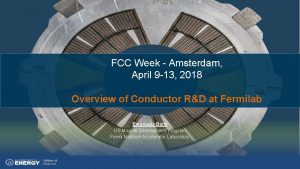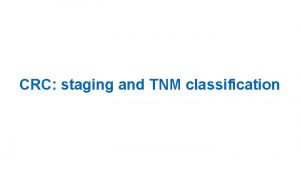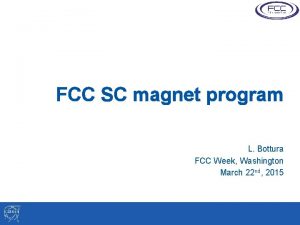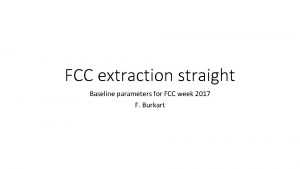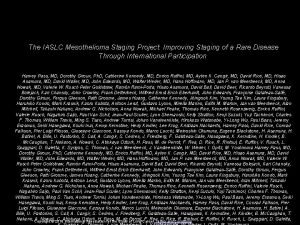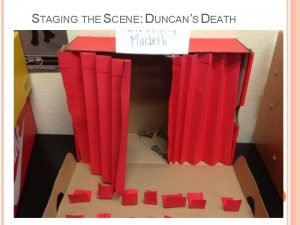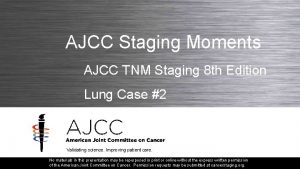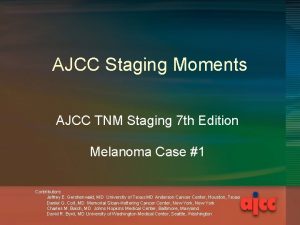FCC Week 2018 Amsterdam Staging and design of




















- Slides: 20

FCC Week 2018, Amsterdam Staging and design of the cryogenic system for FCC-ee and HE-LHC Laurent Tavian, CERN, ATS-DO

Content • FCC-ee conceptual design – Basic input from SRF – Cryogenic plant layout and architecture – Staging proposal from Z W H ttbar 1 ttbar 2 – Electrical consumption and helium inventory • HE-LHC conceptual design – Temperature levels, heat loads & installed cooling capacity – How to deal with existing LHC tunnel and existing cryogenics? – Electrical consumption and helium inventory • Conclusion

FCC-ee: RF configuration for the different machines 1 year Z W 4 K cryogenics H ttbar 1 ttbar 2 2 - 4 K cryogenics

FCC-ee: Heat loads per machine Heat loads largely dominated by dynamic loads (w/o operational margin)

FCC-ee: Cryogenic plant capacity and layout

FCC-ee: cryogenic plant architecture

FCC-ee: Cryogenic architecture

FCC-ee: Cryo-plant staging Refrigeration need per Point: Z W H ttbar 1 ttbar 2 2 16 41 55 63 Upgrade (41 -63 k. W) Point D Cryoplant A Cryoplant B Cryoplant C Upgrade (41 -63 k. W) Point J Cryoplant A Cryoplant B Cryoplant C Reminder: Staging scenario similar to LEP-LHC: - started with two 6 k. W plants - then four 12 -18 k. W plants (LEP 2 – LEP 2+); upgraded with 2. 4 k. W @ 1. 8 K units for LHC. - then four additional 18 k. W including 1. 8 K units for LHC

FCC-ee: Electrical consumption and He inventory Electrical consumption Helium inventory

HE-LHC : temperature -pressure level • Use of FCC-hh cryo-magnet design and cooling principle: T cold-mass @ 1. 9 K and 1. 3 bar • Beam screens cooled between 40 -60 K, which corresponds to the optimum exergetic efficiency. The reduced specific load (8 W/m per beam) allows to operate at 20 bar. Beam-screen

HE-LHC : heat load in steady-state and transient operation + 1. 1 k. W at 1. 9 K per sector to extract deposited energy (AC-losses) during ramp-up in less than 2 hours (Including operational margins of 1. 3 for 40 -60 K and 40 -300 K temperature level)

HE-LHC : Re-use of LHC cryoplant? • The total entropic load is not compatible with existing LHC cryo-plants (18 k. W @ 4. 5 K). New Turbo. Brayton (300 -40 K) Existing LHC plant • However, by adding a. Turbo-Brayton refrigeration stage to produce the cooling capacity above 40 K (equivalent to 9 k. W @ 4. 5 K), the remaining capacity to be produced by the LHC plants is reduced to 16 k. W @ 4. 5 K. The corresponding supercritical mass-flow at 4. 6 K and 3 bar to be delivered in the tunnel is 220 g/s per sector, to be compared with 235 g/s for LHCB plants (new LHC) and with 190 g/s for the LHCA plants (Ex-LEP). • Turbo-Brayton can also be used for precooling of the LHC plant and for sector cool-down. • The aging of the existing LHC plants must also be taken into account (Ex-LEP plants will be 50 -year old in 2040 !). HE-LHC sector • Feasibility study to be continued !

HE-LHC: cryogenics distribution for sector cooling der: n i m e sable R u e r not L R Q g Existin DN 4. 4 k. W @ 1. 8 K B 340 C 100 D 200 E 100 F 100 15 mbar, 4 K, 220 g/s Even Pt Odd Pt Trench enlargement over 27 km!

HE-LHC: cryogenics distribution for ½ sector cooling DN B 230 C 100 D 200 E 100 F 100 G 100 er: d n i ble m a s Re u e not r L R Q g Existin 2. 2 k. W @ 1. 8 K Retain as HE-LHC baseline 2. 2 k. W @ 1. 8 K ~ 4 bar, 30 K, 110 g/s 15 mbar, 4 K, 110 g/s Even Pt 15 mbar, 4 K, 110 g/s Odd Pt More rotating machinery lower global availability But existing LHC 1. 8 K refrigeration unit can be reused (2. 4 k. W @ 1. 8 K)

HE-LHC cryogenic layout 2. 2 k. W @ 1. 8 K refrigeration unit Main sector cryo-plant 23 k. W @ 4. 5 K including 2. 2 k. W @ 1. 8 K Remark: specific cryoplants to be probably added at Point 1 and Point 5 for high luminosity insertion cooling (28 E 34 cm-2. s-1 : reuse of HL-LHC cryo-plants? ).

HE-LHC: Additional civil engineering 2. 2 k. W @ 1. 8 K refrigeration unit Main sector cryoplant 23 k. W @ 4. 5 K including 2. 2 k. W @ 1. 8 K The warm compressor stations must be located in noise-insulated surface buildings: - Space requirement: ~10 x 30 m 2 per unit - Reuse available existing space at P 1, P 2, P 5 ? - New buildings at P 3 and P 7. The cold boxes must be located in underground radiation-free alcoves or caverns: - Space requirement: ~10 x 10 m 3 per unit - Reuse available existing space at P 1, P 2, P 5 ? - New alcoves at P 3 and P 7.

HE-LHC electrical consumption + additional power for high-luminosity insertion cryo-plants

HE-LHC helium inventory • Present LHC inventory (135 t) • Main change due to cold-mass helium inventory: from 25 to 33 l/m, i. e. + 28 t in total • HE-LHC helium inventory: 163 t • To store this additional inventory (28 t), 2 additional LHe storage vessels (120 m 3 unit volume) will be required. Two LHC LHe storage tanks at Point 18

Conclusion • Conceptual designs of FCC-ee and HE-LHC are completed. • For FCC-ee: – Two to four cryo-plants with unit capacity from 2 to 63 k. W @ 4. 5 K have been proposed to cover the need of the 5 machines (Z, W, H, ttbar 1 & ttbar 2) – a staging scenario is also proposed (similar to the scenario proposed for LEP 2, LEP 2+ & LHC). • For HE-LHC: – The integration of the machine in the existing LHC tunnel imposes additional 1. 8 K refrigeration units at the odd Points. – The unit refrigeration capacity per sector is 25 k. W @ 4. 5 K. the feasibility study to partially cover this need by the existing LHC plants has to continue. – The existing LHC distribution line (QRL) is not reusable (different cooling circuit, cell length, header diameter…). – LHC storage infrastructure can be re-used and upgraded by 2 new LHe storage tanks (from 6 to 8). – Cryogenic plants for high-luminosity insertions still to be design.

Thank you!
 Fcc amsterdam
Fcc amsterdam Fcc amsterdam
Fcc amsterdam Fcc week 2019
Fcc week 2019 Week by week plans for documenting children's development
Week by week plans for documenting children's development When is healthy eating week 2018
When is healthy eating week 2018 Dada la siguiente secuencia rusia 2018 rusia 2018
Dada la siguiente secuencia rusia 2018 rusia 2018 Fcc office of engineering and technology
Fcc office of engineering and technology Bcc 110 planar density
Bcc 110 planar density Pros and cons of a traverse stage
Pros and cons of a traverse stage When did anne frank move to amsterdam
When did anne frank move to amsterdam Ted's flight from amsterdam took more than
Ted's flight from amsterdam took more than Messiaanse gemeente amsterdam
Messiaanse gemeente amsterdam Open library amsterdam
Open library amsterdam What country
What country New amsterdam
New amsterdam Amsterdam office market
Amsterdam office market Brabant water hoofdkantoor
Brabant water hoofdkantoor Managed dark fiber
Managed dark fiber Amsterdam housing prices
Amsterdam housing prices Amsterdam bar association
Amsterdam bar association Risk minds conference amsterdam
Risk minds conference amsterdam


